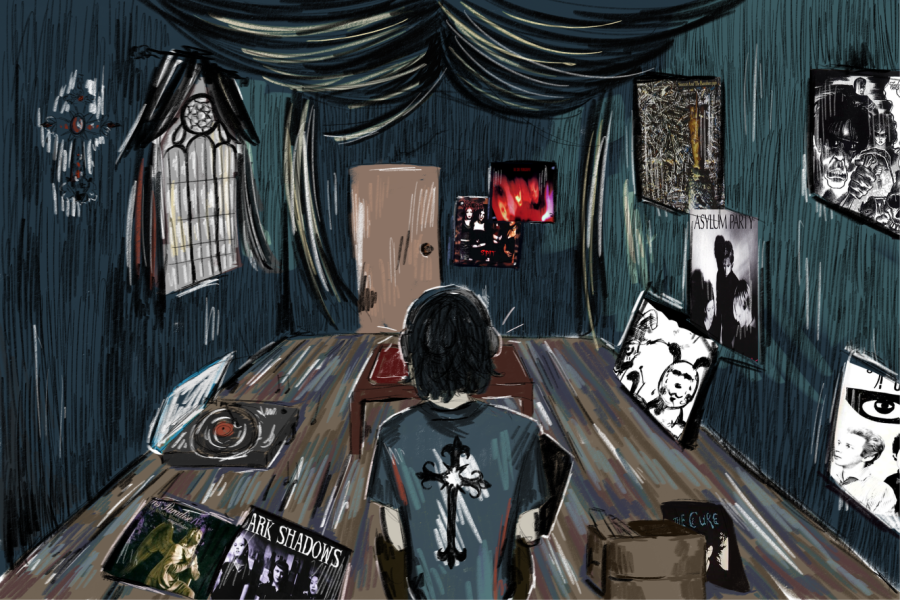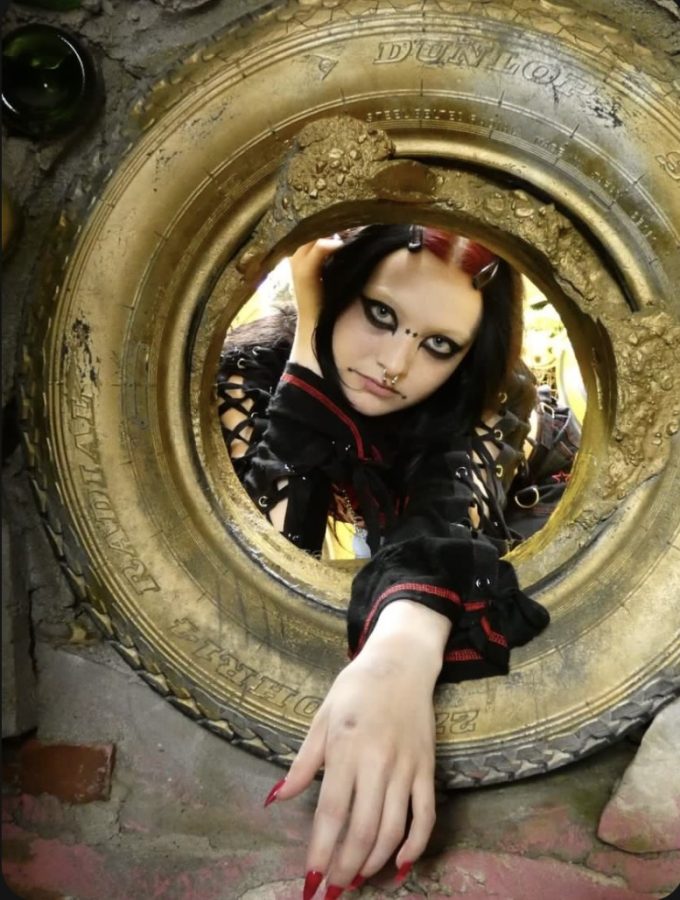Oh my goth! The gloomy subculture that’s eternal
Goth, a music-based subculture that originated in the 1980s from punk subculture, has transformed into an outlet for creative expression flowing about through fashion, lifestyle, music, mood, artistry and more.
May 17, 2023
History
The term “Goth” or “Gothic,” is embedded into thousands of years worth of countercultural movements. In Ancient Rome, among the most powerful Germanic people were known as the “Goths,” composed of two tribal groups- Visigoths and Ostrogoths. As the Roman empire fell apart, the Goths and their tribal armies played a larger role in defense and internal power struggles. In the fifth century however, as the western emperor was deposed by soldier Odoacer, the eastern and western Roman empires would forever be separated. Its power fragmented into kingdoms ruled by Goths and other Germanic tribes who assimilated into local cultures.
During the later Dark Ages, ample cathedrals were built throughout Europe, characterized by their pointed arches, large windows, almost skeletal and ornate. In 1550, novelist Giorgio Vasari was the first to describe them as Gothic, a derogatory reference to the Barbarians thought to have destroyed classical civilization. Henceforth, the term “Gothic” came to be associated with darkness and superstition.
In the 1700s, during the Enlightenment, Romantic authors like Goethe and Byron rebelled against this period by seeking idealized versions of natural beauty, landscape and manner of thought. Here, the word “Gothic” was repurposed again to describe a literary genre.
Moving forward to the 20th century, the goth music scene began to emerge. British post-punk groups like Bauhaus, Joy Division and The Cure, “combined gloomy lyrics and punk dissonance with imagery inspired by the Victorian era, classic horror and androgynous glam fashion.”
Goth, a music-based subculture that originated in the 1980s from punk subculture, has transformed into one big outlet for creative expression flowing about through fashion, lifestyle, music, mood, artistry and much more.
“For me, I see it [Goth subculture] as music that expresses a pessimistic world view,” alum Jasper said. “And, dark themes that counter how the general public is expected to act or think. Goth is a counter-culture.”
Pioneers of gothic rock, the band Bauhaus would perform concerts in elaborate costumes and white face paint, all wrapped up in a dramatic, glum demeanor. According to senior Elena Paz, audiences would begin to mimic their funky appearance, transforming artistic expression into a lifestyle sometimes separate from the music scene entirely.
“I am definitely more sarcastic, vulgar and gloomy when it comes to my behavior since delving into alternative culture,” Jasper said. “In terms of aspirations, I feel that it is my purpose to create music and fashion that is disturbing and volatile.”
Prominent characteristics of gothic rock include heavy basslines, strong percussive beats, distorted guitar sounds and melancholic melodies, all of which can be found in bands like The Cure, The Sisters of Mercy, Type O Negative and Joy Division.
“I think it’s [gothic rock] very theatrical and I feel like a lot of people just see it as a bunch of guitars, which is more metal than goth,” Paz said. “But goth bands, specifically a lot of newer goth bands, will sample opera music.”
According to Jasper and Paz, there are a lot of alternative events in Austin hosted at locations like, The Electric Church and The Tunnels.
“Killer Tits play a lot,” Paz said. “They’re a great band. All of the girls are really nice, fun to talk to and honestly, everybody who goes to shows like that, are so nice. Even though there can be rude people, there’s a sense of community.”
According to Jasper, their interest in gothic subculture majorly stems from fashion, specifically from genres and groups like mallgoth and tradgoth, both of which have accents of color from 90s-2000s media influence. This style of clothing can be found from brands Lip Service, Tripp NYC and Demonia.
“My main interest is collecting mall goth clothing/brands such as these,” Jasper said. “And, collecting gothic staples such as platform shoes/boots and band tees. I have a specific interest in gothic characters such as Lenore, Siouxsie Darkside, Emily the Strange, Skelanimals, Gris Grimly, Ruby Gloom and Scary Miss Mary.”
According to Paz, she was partially introduced to the trad-goth style through her visits to punk shows in downtown Austin.
“They’ve made me want to get more into the subculture because they’re all so unbelievably cool,” Paz said. “They all have the bats nest going on, hairspray galore, eyeliner, white face paint and that black jawline cut with the black face paint.”
Though gothic rock music often plays with themes of death, morbidity and melodrama, certain bands like Siouxsie and The Banshees can be fun, not depressing to listen to, according to Paz.
Bands like Cannibal Corpse, for example, express themselves viciously through their music when in actuality, their lead singer collects stuffed animals for fun. Depeche Mode is said to have great connections with their audiences and is the source of inspiration for many bands, like Linkin Park and The Killers.
“I feel like a lot of people think that alternative music in general is just screaming and aggressively strumming a guitar, but it takes a lot of work to be able to make something like that and to keep doing it frequently,” Paz said.
For Jasper, their true connection lies with alternative subculture, a community they would describe as incredibly nuanced in their expression of genuine mental health struggles, struggles such as suicidal tendencies and intrusive, obsessive thoughts.
“Music and fashion are the only two things that help me express how I feel and think,” Jasper said. “My current identity is rooted in learning to accept my mental health struggles and use them to create media that evokes negative emotion.”
Jasper recommends alternative clothing stores in Austin like Secret Oktober, Aaron’s Rock n’ Roll and Bloody Rose Boutique. Paz recommends one of the first all-female goth bands, Kitty, complimenting their astounding screaming capabilities.
“I had a dream that I met Robert Smith and I fell to my knees and I just started crying,” Paz said. “I was like a ball on the floor and he was just standing there, watching me. He’s my icon.”
Note: World Goth Day is celebrated on May 22.








